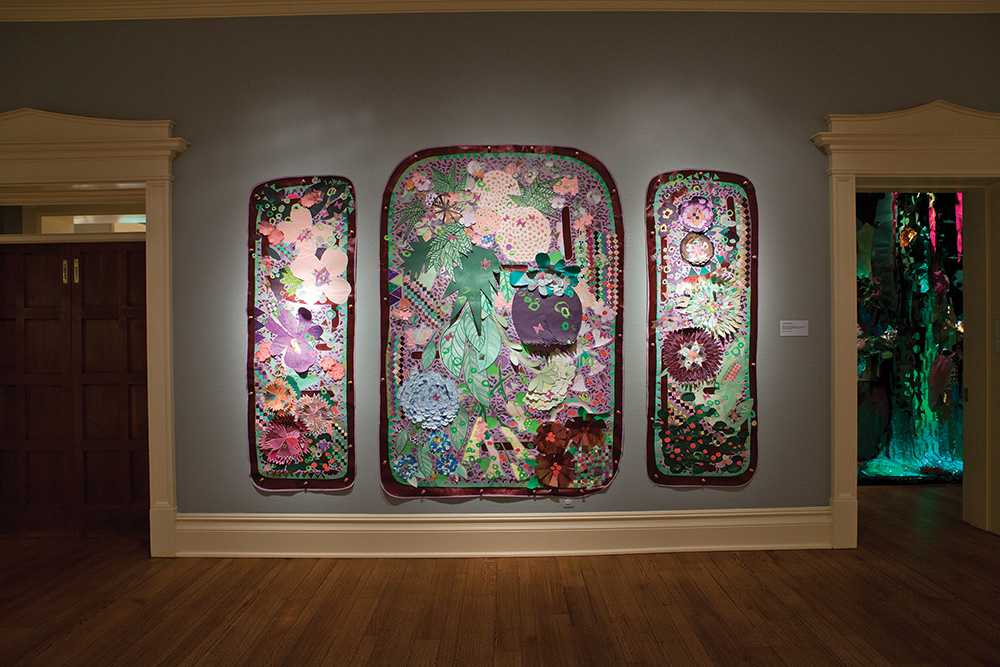Juan Rojo credits his mother for his interest in painting.
A native of Valladolid, Spain, Rojo says, “My mother wasn’t a professional or anything, but she liked to paint with oil. I remember the house smelling like oils. I associate that with my mother. And, I suppose, that was my first connection to art, in a way.”
Between February 11th and March 1st, Rojo will exhibit 17 works in “Vanitas” at Jay Etkin Gallery.
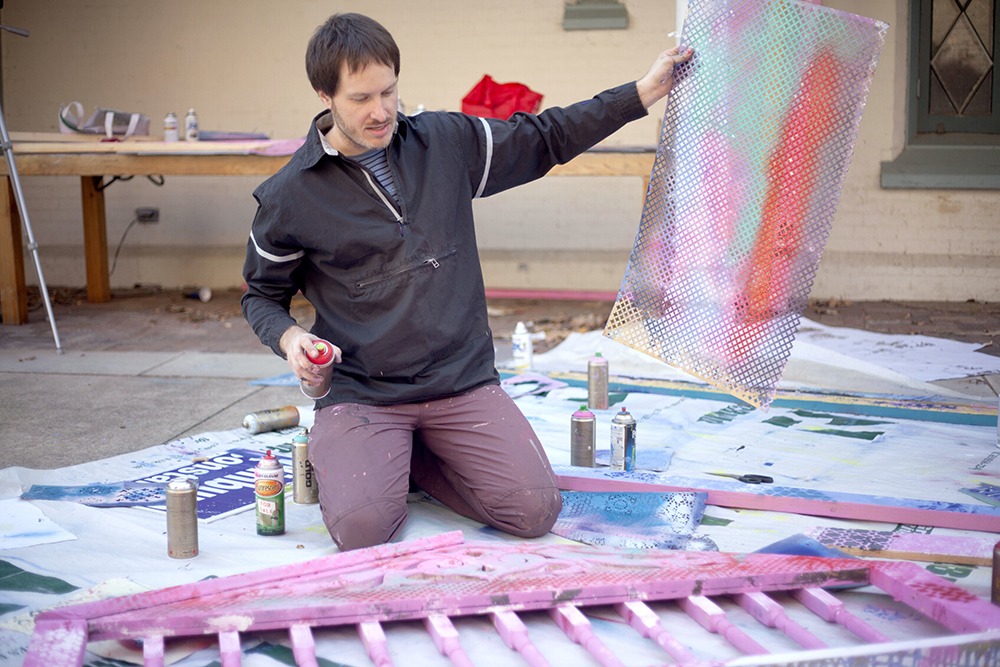
Portrait of the Artist as a Young Man
In addition to exhibiting his works in shows at Etkin, Rojo featured his art in numerous galleries, including the Dixon Gallery & Gardens, where he was included in “Memphis 2021,” and Galeria Rodrigo Juarranz in Burgos, Spain. His work was also in the Affordable Art Fair in London.
Closer to home, Rojo’s works are in the permanent collections of the City of Memphis and the Memphis International Airport. Showing his works in galleries in three countries didn’t happen overnight, though. “I’ve been painting 30 years nonstop this year,” says Rojo, who also teaches art at Southwind High School.
“Juan is one of the strongest figurative artists in town,” says Etkin, who has represented Rojo for many years. “He might be considered a realist, but his paintings are imbued with mystery and emotion and immersed in a surrealist sensibility.”
Rojo, who was more interested in playing “in the streets” as a child, didn’t start doing any type of artwork until he was 12 years old. “I was a very shy kid,” he says. “Very introverted. Drawing was kind of a nice excuse to be alone and do something I enjoy. I was not really good at it, but I really liked the solitude.”
His mother was a “hobbyist” artist. “She did portraits. Very surreal portraits,” Rojo remembers. “When she was young she was not ‘gothic’ — that probably wasn’t a word that was around — but she wore dark clothes.”
His mother liked painting her women in “dramatic” blues, Rojo says. “Like Picasso, in a way. Sad faces, sad women. It was kind of a naive painting. She wasn’t classically painting or trained. She did what she could.”
Rojo just began drawing one day. “I don’t remember the first thing I drew, but I liked to draw people. I started copying the masters. We had a book of art history at the house. When my mother saw that I spent all my days drawing — and my drawings were terrible — she took me to an academy where they paint and draw. I just started learning to draw there.”
Practice makes perfect, and following in the footsteps of the greats doesn’t hurt either. So he copied Michelangelo’s drawings from the Sistine Chapel. “I could draw some of those from memory.”
At the time, Rojo used pencil and charcoal. “I remember saying I didn’t want to paint because painting was boring.”
Drawing was “something I could control in my life. Drawing was very precise and a way to describe things. I got good at it.”
And, he adds, “The human figure has always been my interest. I did some landscapes, but I cannot look at a painting for more than a month if they don’t have eyes. If they don’t return the look, look back, I cannot keep painting that for a year like I do sometimes.”
One of his teachers kept pushing him to start painting, Rojo says. Finally, the teacher had him work on a big painting of one of Michelangelo’s drawings. “Instead of pencil, I did it in paint. I loved it so much. The process. The application of paint.
“I copied it on a canvas. I probably used oil because at that point acrylic was not really a thing [because] the quality was not that good. An ochre and something very toned down. White, brown, black, and ochre to create the shadows and light. The same way you do with pencil.”
Happy with the results, he thought, “Okay, we can try this painting thing.”
Rojo began copying the work of his inspirations: Alberto Giacometti, Frank Auerbach, and Lucian Freud.
He liked Giacometti, in particular, because his paintings are “the bridge between drawing and painting. His paintings are like drawings with a little bit of color. The moment I started mixing colors, I relaxed. That was what I wanted to do.”
Rojo loved the way Auerbach used so much paint in his work. “I started painting highly dense and full of paint.”
Rojo’s early paintings were very expressionistic. “I think I was a natural with painting, so it didn’t take me long. I think I was a better painter than a drawer at that point.”
But he doesn’t describe himself as a “natural artist,” Rojo says. “I tell my students I don’t believe in talent in that sense. My drawings at 14 were terrible, but I loved doing it. At some point I got better and I got good.”

Still Life with School Art
Rojo taught private art lessons to adults and children before he entered the University of Salamanca. “I’ve been teaching since I was very young,” he says, “even like being a counselor at summer camp.”
Salamanca was “very classical, so everything was working with models. We had five years of drawing nude models, five years of painting nude models. So, for me, it was like heaven.”
He met his wife, Clara, who was studying medievalist literature at Salamanca. “I think it was the theory of literature class. And she was there and we met and that was it.”
Juan and Clara married before moving to Washington, D.C., in 2004 so his wife could get her doctorate at Georgetown University.
They lived in Washington for six years. “I came on a spouse visa. You cannot do much on a spouse visa, so I was basically painting for a couple of years.”
Rojo, who got his masters of art at the University of Maryland, moved to Memphis about 10 years ago after his wife got a job teaching Spanish medieval literature and Spanish at Rhodes College.
They loved Memphis from the beginning. “We spent a year in Kentucky — Lexington — after Washington. It was good, but it was a small town. We came here and it was kind of an upgrade.”
Rojo quickly got into the Memphis art scene and began showing his work. “It’s not that hard, in Memphis, to meet the art community.”
While showing his work at the old Circuitous Succession Gallery, Rojo met Etkin. “When the gallery closed, I approached Jay and we started working together.”
Rojo taught for a couple of years at the University of Memphis until his wife got a fellowship at the University of Notre Dame. Rojo taught at Notre Dame as a visiting artist for a year. “I did a lot of photography there,” he says. “That really helped me in my work.”
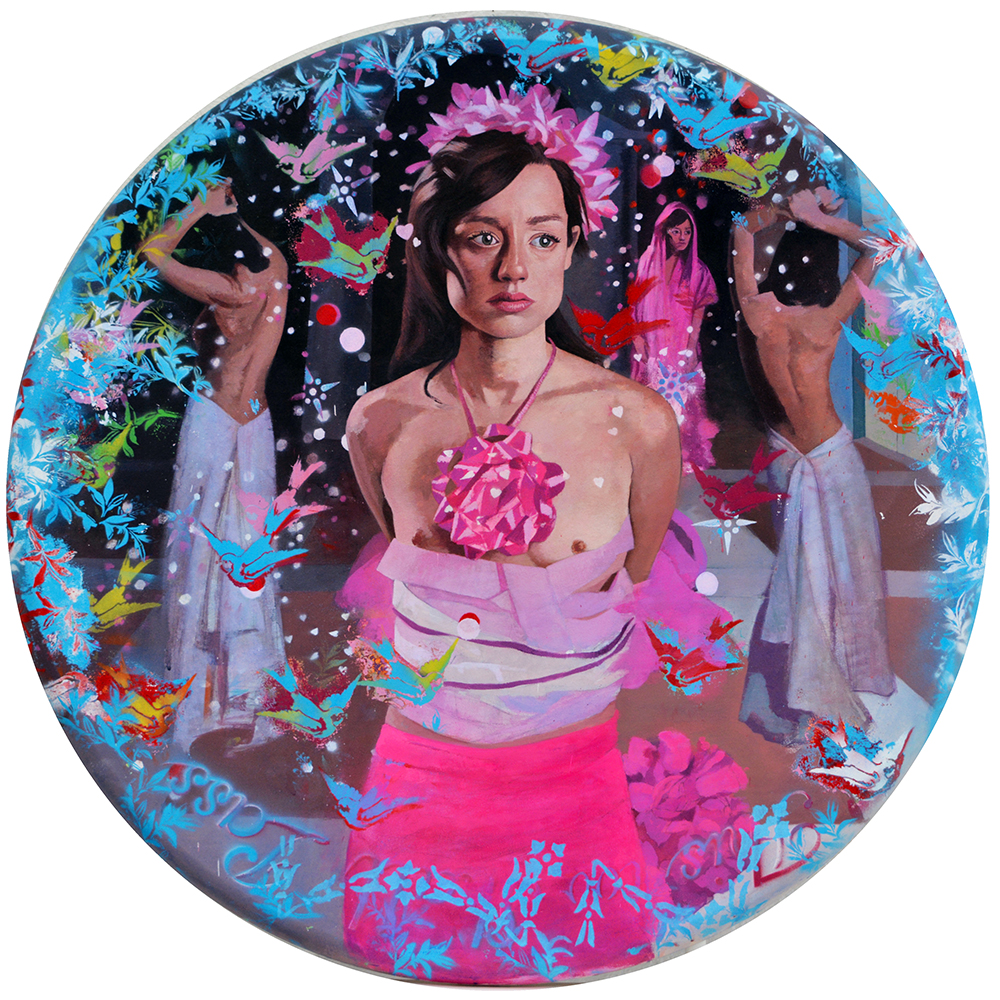
No Cookie-Cutter Compositions
After returning to Memphis, Rojo began teaching art at Southwind High School. It wasn’t easy at first. “When I started, it was just surviving,” he says.
It took him a while to learn the methods for managing a classroom, Rojo says. “The things you do and things you don’t need to do. You learn on the job. The first year was tough. The second year was tough. By the third year, I knew how to run a class and just really get the kids involved in art. Get them involved in what they want to do in art.”
He found his students responded when he told them, “Now I’ll teach you how to do this. What do you want to do with this?”
Rojo says, “They love that. They want to draw what they want. Design what they want. Within the margins of what they learn to do in class.”
And, he adds, “I realized soon if you give the kids choices and give them options to do what they want, they surprise you.”
Rojo knew what he did not want to do as an art teacher. “Sometimes art is like a cookie maker,” Rojo explains. “Kind of cookie-shaped things. You tell them everything and at the end you have 35 cookies that are the same. I hate that. I don’t do that.”
Eventually, he began having his students paint murals. “We paint some of them outside, some of them inside. We have seven murals in the high school.”
Rojo makes sure to keep his students involved in every step of the process, so the students come up with the subjects for the murals. “They choose, so some of them are weird and scary.”
The students vote on what subject they want to paint. “I take it to the principal and he approves them and they do them. I don’t have a part in the creative process of this and I don’t want to. I’m just helping them build up their ideas.”
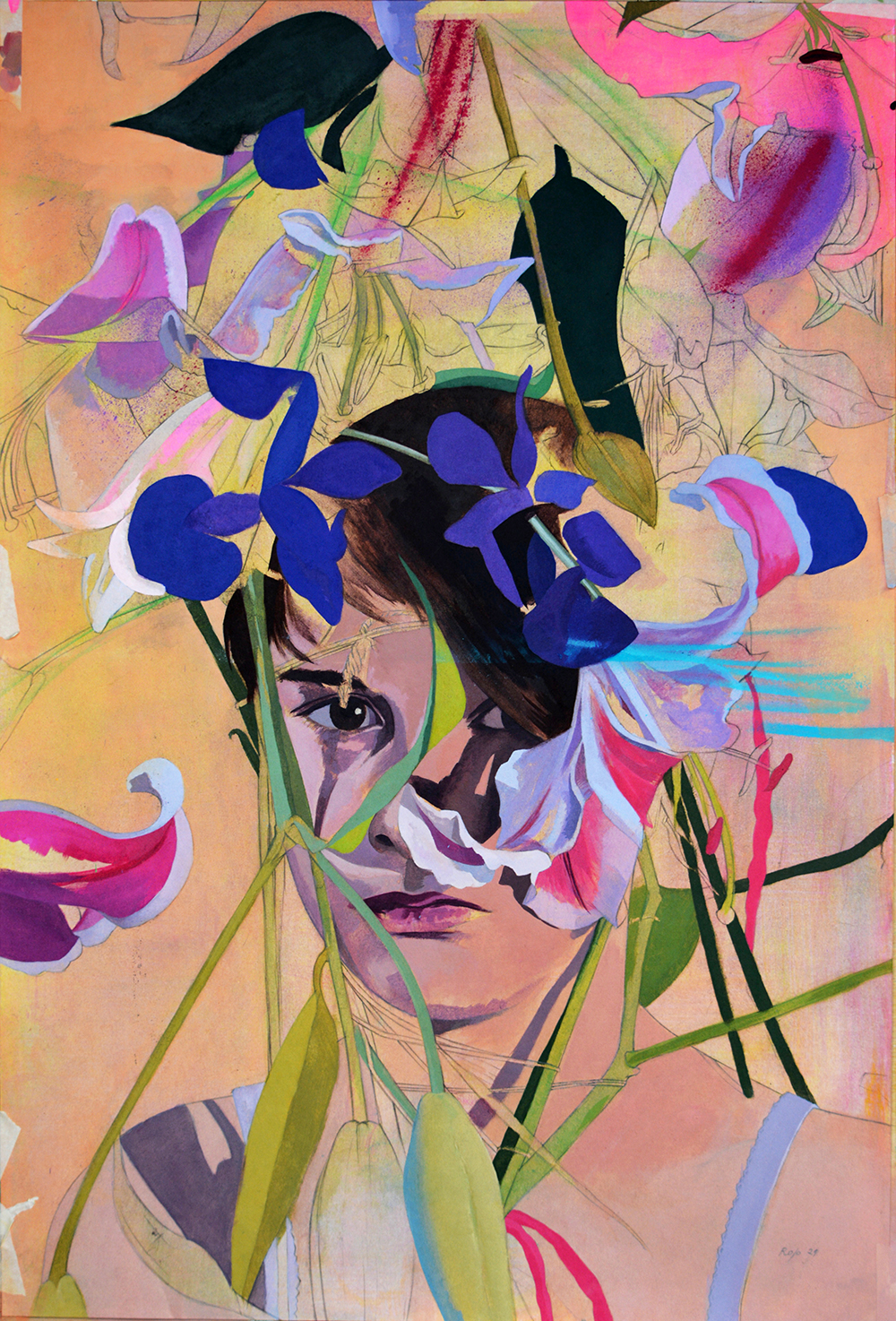
the floral motif within Rojo’s “Vanitas” collection.
“Vanitas”
As for his own work, Rojo says his paintings have changed over the years. He switched to acrylics instead of thick oils after he moved to the United States. His paintings became flatter. But, he says, “The common thread is the human figure.”
“Vanitas” paintings are a type of still life. “You have flowers. You have a skull. You have things that die. They are passing. Future or life is like a dream, in a way, that goes so fast.”
“Vanitas” paintings are about “the mortality of people,” the artist explains. They capture the finite nature of all things — cut flowers, human lives — and highlight the importance of these fleeting moments.
Rojo’s paintings have elements of vanitas in them, but instead of focusing on death, the paintings in his “Vanitas” show are “more about enjoying life while it lasts.”
He places flowers and other objects on his models, photographs them, and then does a painting using the photograph as a reference. The artist can be found “literally tying down the flowers to their heads. I use flowers and things that are going to die. It’s not permanent, what I build there. That beautiful scene that I build is not made to be permanent. It’s ephemeral sculpture.”
The flowers and other objects “have expiration dates. Not the painting, but the object. Once they [the models] move, they fall. And then that image disappears. Like, literally, you cannot really hold the same pose for more than a minute before things start falling from your head. Delicately placed there, it wants to be permanent, but it can’t be.”
Rojo mostly uses women models. “If I feel confident enough, I can get some level of intimacy with the models, attaching things to their heads. They need to be comfortable with me doing that. Normally, I feel more females are going to be better with that. But I have male models, too. It’s not an exclusive thing. It’s just a matter of who I have confidence and trust in that this is going to be fun for both of us, the process is going to be comfortable for both of us and they will enjoy it,” the artist explains.
It took Rojo about two years to complete his show at Jay Etkin Gallery. “This one is purely all pandemic. During the pandemic I didn’t have models. I could have, I suppose, but I didn’t feel safe bringing models to the studio. So, I’ve been painting a lot of my daughter because she was there in the house. But also using old photographs, images of models I took over the years.”
Rojo had plenty of time to paint during the pandemic. “We taught from home. So, for almost a year, I did my class from my computer. And the rest of the day I painted. I didn’t have drive time, so I could work more on the paintings.”
Some of the works, which are in a round format, are based on snow globes. “A lot of the paintings in this show are like things frozen in time. That’s how I felt with the quarantine and the pandemic. Everything is kind of still. Frozen.”
Instead of snowflakes, Rojo has “things floating like they’re inside of snow globes.” Like leaves and birds.
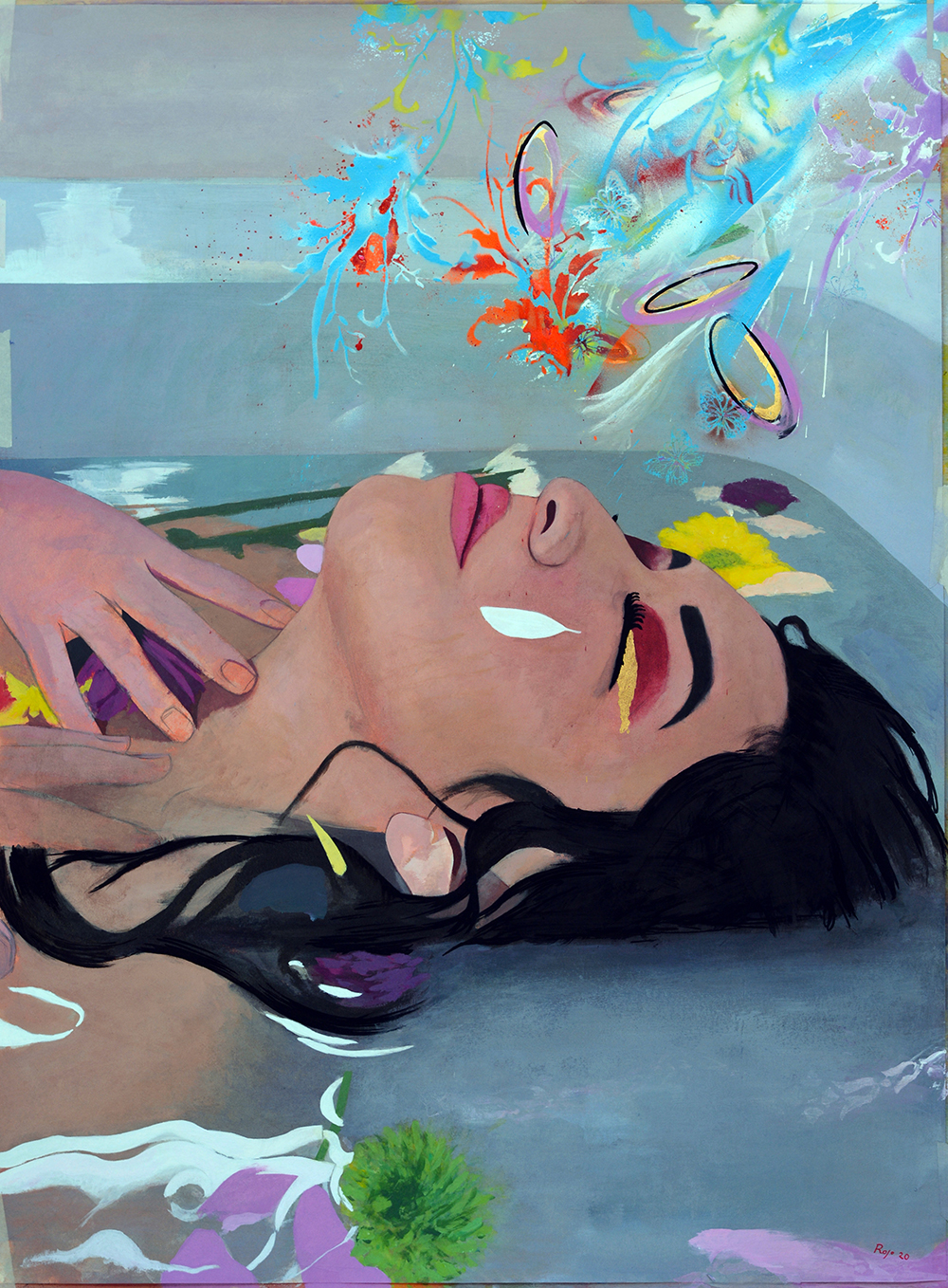
What Comes After
Rojo plans to include soap bubbles in his paintings in his next show, he says. “Soap being something that goes fast. They’re beautiful and they explode. Like death, I suppose, in a way.”
Rojo also will be in some of his new paintings. “A friend of mine took photos of me with things on my head. I’m excited about that. They were pretty amazing. Flowers and stuff. Some classical. Saint Sebastian. The guy that’s got the arrows. Some funny stuff will see the light at some point.”
Rojo also includes drawings in his Etkin show. He did a series of drawings and watercolors of lilies and carnations from the time they are alive to the time they die. He recorded their life span by observing them. “I didn’t use photographs.”
In addition to his work for the “Vanitas” show, Rojo completed an UrbanArt Commission mural last December. He created and painted a mural for Porter-Leath & University of Memphis Early Childhood Academy at Orange Mound. The 9-by-18-foot mural features 23 figures.“It’s based on classical compositions from the Renaissance. I designed it with four layers of kids running around, going on bicycles. Some are blowing bubbles.”
One of his paintings was acquired for the soon-to-open new terminal of the Memphis International Airport. “A painting of my daughter under the tree in my backyard.”
Fellow Memphis artist Carl E. Moore is a Rojo fan. “Juan Rojo is a friend and one of the most consistent and productive artists I know because of his studio practice and his work ethic,” Moore says. “His art is full of playfulness, passion, and drama created with color and composition painted as a theatrical performance. His style is a playful use of wardrobe and props, allowing his muses to become the center of the creative artwork.”
Rojo is in a good place in his life. “In terms of art and producing art and selling art, I’m getting appreciated,” he says. “It’s been a really nice time. A horrible time to be living in, but I cannot complain. I’ve been very lucky in the last year and a half.”
“Vanitas” is on view at Jay Etkin Gallery from February 11th through March 1st. Jay Etkin Gallery is at 942 Cooper Street; (901) 550-0064.

